Value of Five Shilling Coin 1953: Worth & Identification Tips
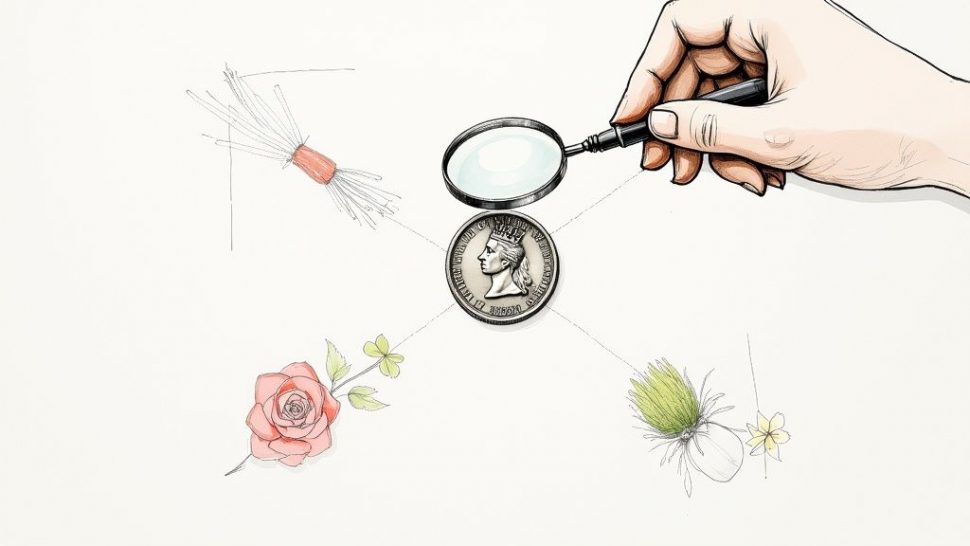
Posted by: Ian • 28 Sep 2025
When trying to figure out the value of a 1953 Five Shilling coin, one thing becomes clear very quickly: its condition is everything. A well-worn coin might only be worth a few pounds, but a flawless, uncirculated example can fetch a much higher price. While this coin, often called the Coronation Crown, is quite common, its connection to a major historical event keeps it firmly on the radar for collectors.
Uncovering the Story of Your Coronation Crown
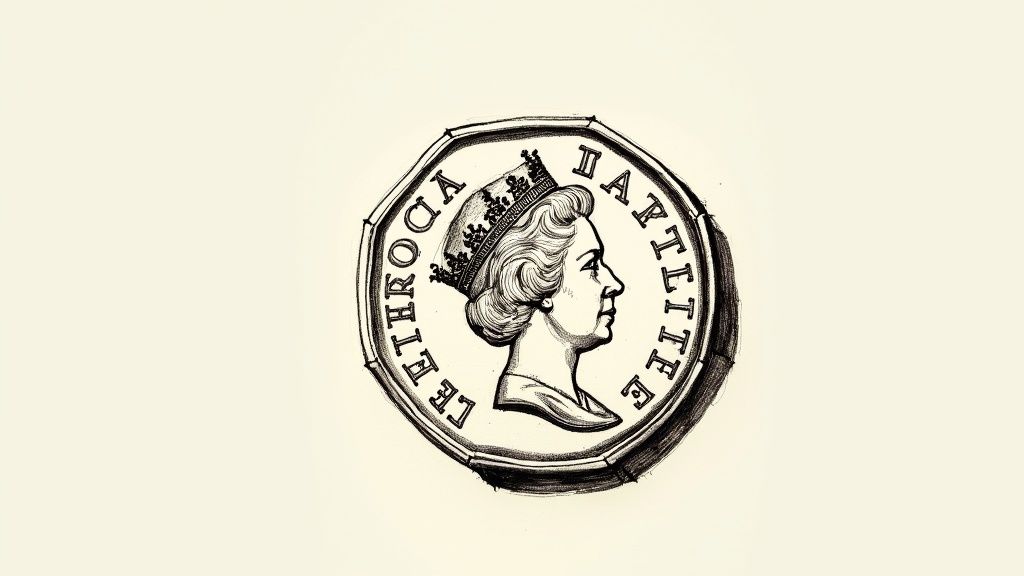
If you've stumbled across a 1953 Five Shilling coin, you're holding a genuine piece of British history. This isn't just another old coin rattling around in a drawer; it was struck to celebrate one of the most significant royal events of the 20th century. Getting to know its story is the first step in understanding its real value, which goes far beyond just the metal it's made from.
A Coin for a Queen
At its heart, this coin is a commemorative piece. The Royal Mint issued the 1953 Five Shilling coin to mark the coronation of Queen Elizabeth II, which is why it earned the nickname the "Coronation Crown."
It had a face value of five shillings—the equivalent of 25p after decimalisation—but it was never really intended for popping to the shops. Its true purpose was to be a souvenir for the public. Millions were minted, and because they were often tucked away as keepsakes, a great many have survived in relatively good shape.
This coin is part of a long and fascinating tradition in British currency. To see how it fits into the bigger picture, you might find our guide on the value of shilling coins an interesting read.
Why Condition Is Everything
Here's the crucial bit: the Coronation Crown is made from cupronickel, an alloy of copper and nickel. This means it has no precious metal value to fall back on, so its worth as a collectible is tied completely to its physical condition, or what we call its 'grade'.
A coin that was carefully preserved in its original box will look worlds apart from one that’s been passed around, and that difference is reflected directly in its price tag.
To give you a better idea of what to look for, here's a quick table summarising the key grades and their typical values.
1953 Coronation Crown Quick Value Guide
| Condition | Typical Estimated Value (GBP) | Key Characteristics |
|---|---|---|
| Well-Worn | £0.50 – £2 | Heavy wear, major details are flat. More sentimental than monetary value. |
| Average Circulated | £3 – £5 | Moderate wear on high points like the Queen's portrait. Lacks original mint shine. |
| Extremely Fine (EF) | £5 – £10 | Light wear, sharp details remain. Traces of original lustre might be visible. |
| Uncirculated (UNC) | £10 – £20+ | No signs of wear at all. Looks brand new with full mint lustre. |
As you can see, the jump in value between a circulated coin and an uncirculated one is significant. This is why a close inspection is so important.
What Are Collectors Looking For?
When assessing a coin, a collector or dealer will look for a few key things:
- Lustre: Does the coin still have that original, satiny shine it had when it left the mint?
- Wear: Are the highest points of the design, like the details on the Queen's equestrian portrait, worn smooth?
- Marks: Are there any distracting scratches, rim dings, or blemishes on the surfaces?
In essence, figuring out your coin's value starts with an honest look at its physical state. A pristine coin tells a story of careful preservation, while a worn one speaks of a long journey through many hands.
Later on, we’ll get into the nitty-gritty of how to grade your coin properly. For now, just remember that its appearance is the single most important factor in determining the value of a five shilling coin from 1953.
The Story Behind the Coronation Crown Design
Every coin tells a story, but the 1953 Five Shilling piece is practically shouting from the rooftops about a monumental moment in British history. To really get a feel for its value, you have to look past the metal it's made from and dive into the symbolism packed onto its surface. This isn't just a bit of old money; it’s a carefully designed piece of art, created to capture the optimism and spirit of a brand new royal era.
The design was a very conscious, and frankly quite powerful, statement. It deliberately broke with tradition to celebrate Queen Elizabeth II's ascension to the throne, giving us a fascinating window into the national mood of the time.
A Striking Equestrian Portrait
The first thing that hits you about the 1953 Crown is the 'heads' side, or obverse. Instead of the usual side-profile portrait we'd come to expect, it features a wonderfully dynamic image of the young Queen Elizabeth II on horseback. She's depicted in her full Colonel-in-Chief of the Grenadier Guards uniform, confidently riding her horse, Winston.
This was a bold move. The equestrian portrait, skillfully crafted by the artist Gilbert Ledward, was a real departure from the norm for British coins. The choice was deeply symbolic, presenting the new monarch not just as a figurehead, but as a strong, capable leader ready to take the reins. It’s this unique design that instantly makes the 1953 Crown stand out from the crowd.
Around the portrait is the traditional Latin inscription: 'ELIZABETH II DEI GRATIA BRITT OMN REGINA FIDEI DEFENSOR'. This translates to, "Elizabeth II, by the Grace of God, Queen of all the Britains, Defender of the Faith."
Uniting the Kingdom on the Reverse
Flip the coin over, and you'll find an equally thoughtful design on the reverse, brought to life by Edgar Fuller and Cecil Thomas. This side features a central crown, encircled by four shields, each proudly displaying a national emblem. For any coin enthusiast, this arrangement is a classic and powerful symbol of a united kingdom.
The four emblems are:
- The English Rose: A timeless floral symbol for England.
- The Scottish Thistle: Representing the proud and resilient spirit of Scotland.
- The Welsh Leek: A historic emblem deeply rooted in Welsh identity.
- The Irish Shamrock: The instantly recognisable symbol for Northern Ireland.
This beautiful, complex design brought together the four nations of the United Kingdom under the single institution of the monarchy. You can find even more details about this historic coin's creation and meaning over at cointrust.co.uk.
When you understand the artistry and symbolism woven into both sides of the coin, it transforms. It's no longer just about its potential monetary value; it becomes a tangible piece of history that you can actually hold in your hand.
Whether you're looking to exchange foreign coins, turn leftover foreign currency into cash, or simply get a better handle on your collection, appreciating the story is all part of the fun. For many people, finding a coin like this is the first step in turning forgotten change into something useful—a process we've made fast, easy, and completely hassle-free. Our trusted service is here to make sure your collection, no matter how mixed, is handled with the care it deserves.
How to Grade Your Coin Like an Expert
Ever wondered why one 1953 Coronation Crown fetches just a few quid, while another sells for a surprisingly high price? The secret is all in its condition, or what collectors call its ‘grade’. Let’s break down how you can assess your own coin, so you can move from just owning it to truly understanding its potential.
You don’t need to be a professional numismatist to get a solid idea of your coin’s grade. It really just comes down to knowing what to look for. The difference between a coin that’s seen a bit of life and one that looks like it just left the Royal Mint is the single biggest factor affecting the value of a five shilling coin from 1953.
This image below really drives the point home, showing the vast difference between the coin's face value back in the day, its worth adjusted for inflation, and what a collector might actually pay for it now.
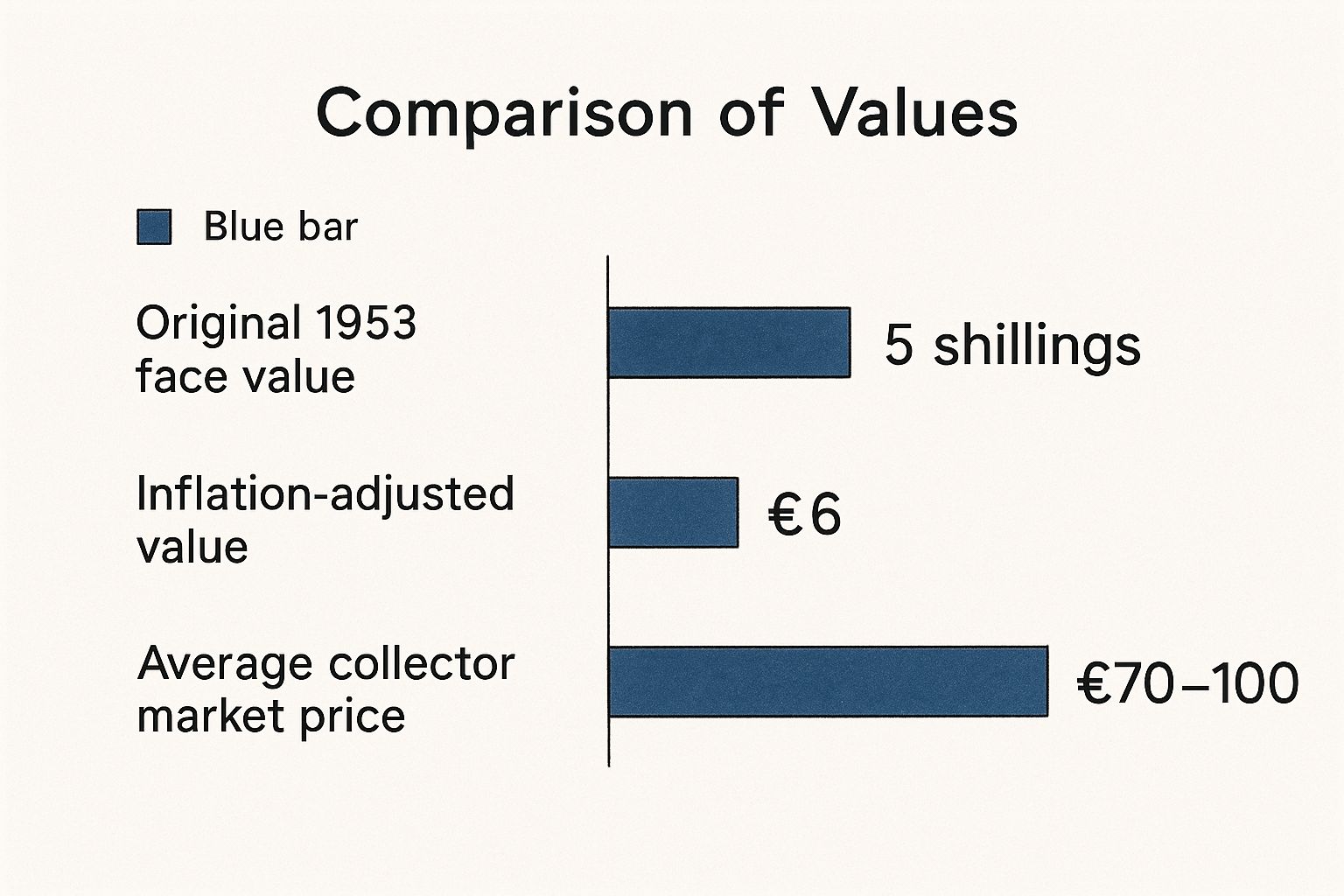
As you can see, the real value isn't about its old spending power. It’s all about its condition and how much it appeals to today’s collectors.
What to Look For: A Practical Guide
To grade your coin accurately, you need to focus on the highest points of the design. These are the bits that get worn down first from being handled. Get a good light, maybe even a magnifying glass, and pay close attention to the stunning equestrian portrait of the Queen on the obverse (the 'heads' side).
- The Queen's Portrait: How sharp are the details on her uniform? Can you make out the lines in her hair and the contours of her face? On coins with a lot of wear, these areas will look flat and indistinct.
- The Horse: Take a close look at the horse's mane, the details on the bridle, and the definition of its muscles. These fine details are the first to disappear with wear and tear.
- The Reverse Emblems: Flip the coin over. Check the sharp edges of the central crown and the delicate lines within the rose, thistle, shamrock, and leek.
A coin that has been passed around will quickly lose its original ‘mint lustre’ – that unique, satiny sheen it had when it was first struck. An Uncirculated (UNC) coin will have this lustre completely intact, giving it a cartwheel effect as it catches the light.
Visual Guide to Grading Your Coronation Crown
To make it even clearer, here’s a quick-reference table. Use it to compare what you see on your coin with the standard features for each grade.
| Grade | Obverse (Queen on Horseback) | Reverse (Crown & Emblems) | Overall Appearance |
|---|---|---|---|
| Fine (F) | Major details are gone. The Queen’s uniform and the horse’s mane are mostly smooth. | The high points of the crown and emblems are flat. The finer lines are worn away. | Looks noticeably worn and has been in circulation for a long time. Lacks any shine. |
| Very Fine (VF) | Moderate wear is visible. You can still make out some details on the uniform and mane. | The main shapes are clear, but the intricate details within the emblems are fading. | A coin that has clearly been used but is still respectable. Details are visible. |
| Extremely Fine (EF) | Very light wear, only on the absolute highest points. The Queen's hair is still sharp. | Almost all details are sharp and clear. The emblems are well-defined. | A sharp-looking coin. Might even have hints of its original mint lustre in protected areas. |
| Uncirculated (UNC) | No wear at all. Every detail is crisp and perfect, just as it left the mint. | Perfect detail on the crown and emblems. All lines are razor-sharp. | Looks brand new. Has a full, unbroken mint lustre that shines across the surface. |
This table should give you a strong starting point for placing your coin on the grading scale.
Understanding the Main Grades
Professional graders use a detailed numerical scale, but for our purposes, understanding these four main categories is more than enough to get an accurate assessment.
I always tell people to think of it like a second-hand car. A model with almost no miles on the clock and perfect paintwork is worth far more than the exact same car that's been used for the daily school run for years. It’s the same principle: less wear equals more value.
Here's a simple summary of what those grades mean:
- Fine (F): The coin shows obvious, significant wear. You can see the main design, but many of the finer details on the Queen's uniform and the horse have been rubbed smooth.
- Very Fine (VF): There's clear wear on the highest points, but it's not as severe as a Fine coin. You can still trace some of the lines in the horse’s mane and the Queen's hair.
- Extremely Fine (EF): The wear is very light and only visible on the very highest points of the design. The coin looks sharp, and you can often see a good amount of the original mint lustre shining through.
- Uncirculated (UNC): This coin looks exactly as it did the day it was made. There are absolutely no signs of wear, and that beautiful original lustre is complete and unbroken.
By using this guide, you can confidently figure out your coin's condition. This knowledge is not only powerful for the Coronation Crown but will also help you assess any other coins you might come across in the future.
Searching for Rare Errors and Varieties
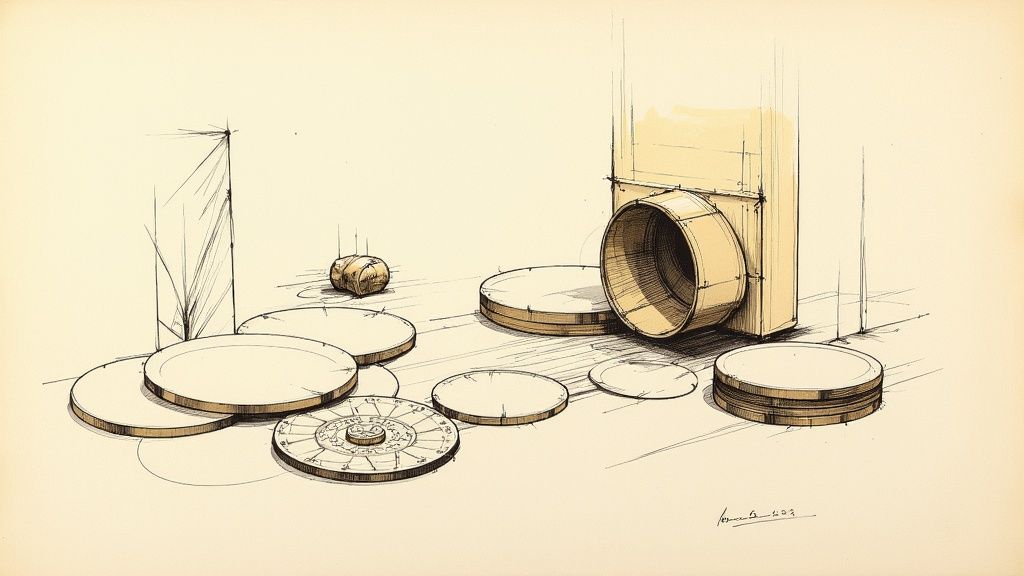
With nearly six million 1953 Coronation Crowns minted, you might think they're all the same. But for the sharp-eyed collector, that's where the real fun begins. The excitement is in the hunt for the tiny imperfections and special versions that made it past the Royal Mint’s rigorous checks. Spotting one of these can seriously increase the value of a five shilling coin from 1953.
It’s a bit like finding a first-edition book with a printing error – the standard copy is nice, but the quirky one is what collectors truly prize. This is the point where a good magnifying glass becomes an essential tool.
Distinguishing Proof Coins from Standard Issues
The most sought-after and valuable version of this coin is the proof. These weren't made for your pocket; they were crafted specifically for collectors. The Royal Mint used specially prepared dies and highly polished coin blanks to create them.
The difference is immediately obvious. Proof coins have an incredible mirror-like finish in the background, which contrasts beautifully with the sharp, frosted details of the design itself. This "cameo" look is a world away from the standard satin finish you'll see on a regular Uncirculated coin.
A proof coin is essentially the minting process perfected, displaying the artist's design in its absolute best light. Finding a 1953 Crown in proof condition is a major win for any collector, as their production numbers were very limited.
Hunting for Minting Errors
Aside from the deliberate perfection of proofs, you can also find accidental errors made during production. These little quirks are what make a common coin fascinating to a numismatist, and their rarity often boosts their value.
Here are a few common types of errors to keep an eye out for:
- Die Cracks: The dies used to stamp coins eventually wear down and can form tiny cracks. When this happens, the crack leaves a faint, raised line on the coin's surface.
- Off-Centre Strikes: This error occurs when the blank coin isn't lined up perfectly before being struck, pushing the entire design off to one side.
- Ghosting: Sometimes, you can see a very faint outline of the design from one side showing through on the other. This is caused by the immense pressure of the strike displacing the metal.
Finding these subtle flaws takes a bit of patience and a careful eye, but it's a genuinely rewarding part of coin collecting.
Even if you don't find a rare error, you might have other leftover foreign currency or old coins lying around. Our service offers an incredibly straightforward way to exchange foreign coins and notes. It’s a fast, simple, and 100% guaranteed method to turn your entire collection into cash without any need for sorting. We’re trusted by major charities, airports, and even police forces, so you can be sure of a credible and hassle-free process.
Turn Your Old Coins into Cash the Easy Way
So, you’ve learned all about the 1953 Five Shilling coin—its history, how to grade it, and what it might be worth. This might have you looking at that forgotten jar of old shrapnel and leftover holiday money in a whole new light.
Maybe you’ve got a mix of obsolete European currencies, some old British shillings, or a random assortment of coins from your travels. Working out what to do with it all can feel like a mammoth task. But it doesn't have to be.
The best part? You don’t need to spend your weekend squinting at tiny inscriptions or sorting through piles of different denominations. There’s a genuinely simple, quick, and hassle-free way to turn all of your unwanted currency into cash.
A Service Built on Trust and Simplicity
We’ve created a service specifically for people like you, with mixed bags of old and foreign money. We know your time is precious, which is why our process gets rid of the most boring part of the job: the sorting. Just gather up all your coins and notes—no matter how jumbled—and send them our way.
Our promise of a smooth, straightforward experience is 100% guaranteed. We've built our reputation on being transparent and reliable, which has helped us earn the trust of some major UK brands.
We are proud partners with leading organisations, including national charities, major supermarkets, airports, and even police forces. These partnerships highlight our credibility and the trust placed in our ability to handle currency efficiently and professionally.
This means you can feel completely confident when you choose to exchange foreign coins and notes with us. We handle every collection with care, making sure you get a fair value.
Practical Tips for Your Unsorted Currency
Dealing with old currency shouldn’t be a headache. Whether you want to convert foreign coins and banknotes or finally clear out that drawer of old money, here are a few pointers to get you started:
- Don't worry about condition: Unlike a collectible like the 1953 Crown, most withdrawn currency is valued by its weight and denomination. There’s no need to waste time cleaning or polishing the coins.
- Mix it all up: Our service is built for mixed lots. Just gather all your leftover foreign currency—from old Spanish pesetas to pre-decimal British pennies—and pop it all in one package.
- Consider donating: If you're feeling generous, you can also donate foreign coins to charity through us. It's a brilliant way to turn forgotten money into something meaningful for a good cause.
The whole idea is to make this as easy as possible. You can get started straight away and see for yourself how simple it is to cash in on old money. If you have a stash of old British currency, our guide on the easy way to exchange old British coins and notes is especially useful.
Our goal is to take the hassle out of currency exchange, making it a quick, easy, and rewarding experience for you.
What to Do With Your 1953 Shilling and Other Currency
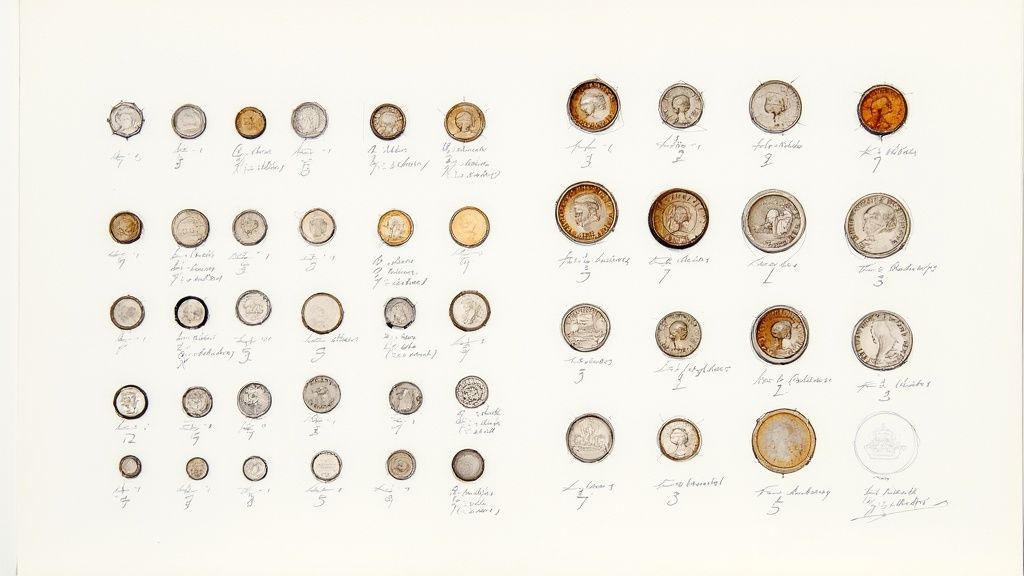
So, you've got a good grasp on the history and potential value of a five shilling coin from 1953. But what about all the other odds and ends you might have tucked away? Think about that jar of old British pennies, the leftover holiday euros, or that envelope of obsolete banknotes. All of that can be turned back into useful cash.
A Simple and Guaranteed Solution
We've designed our service to be fast, easy, and completely hassle-free. The best part is that you don’t need to do any of the tedious sorting yourself. Just gather all your coins and notes, pop them in the post to us, and we’ll handle everything from there.
Our service is 100% guaranteed and trusted by some of the UK’s biggest brands, including national charities, supermarkets, airports, and even police forces. That should give you complete peace of mind.
Whether you're looking to exchange foreign coins and notes, convert that bit of leftover foreign currency, or even donate foreign coins to charity, our process is the simplest way to get it sorted.
Ready to turn your old and foreign currency into cash? Our process is straightforward, secure, and requires absolutely no sorting on your part. It’s the easiest way to make your forgotten money valuable again.
If you'd like to explore other avenues as well, our guide on the best places to sell old coins offers some really useful insights.
Got Questions? We’ve Got Answers
Here are a few of the most common questions we get about the 1953 Five Shilling coin and what to do with old currency in general.
Is the 1953 Five Shilling Coin Actually Made of Silver?
That's a great question, and it's a common misconception. Despite its bright, silvery look, the 1953 Coronation Crown is actually made from cupronickel (a mix of copper and nickel).
This means its value isn't tied to precious metals. Instead, its worth comes down to its historical significance and, most importantly, its condition. While earlier shillings did contain silver, the practice had been phased out well before 1953.
What’s a 1953 Coronation Crown Worth in Perfect Condition?
An Uncirculated (UNC) 1953 Five Shilling coin is a completely different beast from one that's been rattling around in a tin for decades. While the market is always shifting, a pristine, top-grade example will always command a much higher price from collectors.
These are the people who want the absolute best-preserved example of this historic piece for their collections, and they're willing to pay for it.
Can I Pop Down to the Shops and Spend a 1953 Five Shilling Coin?
Unfortunately, no. The 1953 Five Shilling coin is no longer legal tender. It was officially taken out of circulation after the UK went decimal back in 1971.
Today, its value is purely numismatic—a term that simply means it’s for collectors, not for spending.
What's the Simplest Way to Deal With a Big Collection of Old Coins?
If you've got a mix of old coins and notes, sorting through them all can be a real headache. The most straightforward approach is to use a specialised service like ours to exchange foreign coins and notes.
We've designed our process to be fast, easy, and 100% guaranteed, cutting out all the usual hassle.
There's no need to spend hours sorting through your leftover foreign currency or trying to identify every single coin. Just send the whole lot to us, and we take care of everything. We're trusted by charities, major supermarkets, airports, and even police forces, so you know you're in safe hands.
This method not only saves you a huge amount of time but also makes sure you can turn your entire collection into cash with minimum fuss.
Ready to see what that forgotten currency is worth? At We Buy All Currency, our fast, easy, and hassle-free service makes it simple and secure to unlock the value in your old coins and notes. Get started on our homepage today and find out what might be hiding in your drawers.
